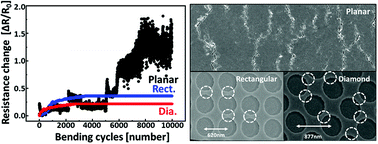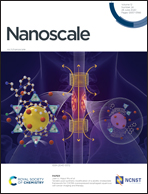Enhanced bendability of nanostructured metal electrodes: effect of nanoholes and their arrangement†
Abstract
Metallic thin films often exhibit poor mechanical robustness, which makes them unsuitable for use as electrodes in flexible and stretchable electronic devices. This prompted us to investigate the effect of creating a pattern of nanoholes in a metallic thin film to its mechanical and electrical properties. The adoption of nanonetwork structures is shown to confer significantly improved bendability to the films, with a change in electrical resistance of only 21% after 10 000 bending cycles, under a bending strain of 6.3%. In contrast to the planar silver (Ag) films in which large cracks are formed, structures that contain nanoholes act as barriers that block the growth of cracks; consequently, only short cracks are formed in these films and therefore changes in their resistance are much lower. In this paper, we suggest a novel model based on random grain boundaries to simulate the behavior of various nanopattern arrangements when the film is subjected to mechanical stress. Our modeling studies revealed that nanoholes secure the electrical current pathways by effectively blocking crack propagation, and that optimizing orientation, size, and coverage of these nanoholes can further improve the mechanical properties. Although diamond patterns exhibit superior characteristics to those of rectangular ones, their directional dependence is shown to be reduced by adopting randomly dispersed nanostructures. We additionally verified experimentally that an array of holes (rectangular, diamond-shaped, and randomly patterned) significantly affects crack propagation and resistance change.



 Please wait while we load your content...
Please wait while we load your content...